
Brixton is a district in South London, part of the London Borough of Lambeth, England. The area is identified in the London Plan as one of 35 major centres in Greater London. Brixton experienced a rapid rise in population during the 19th century as communications with central London improved.
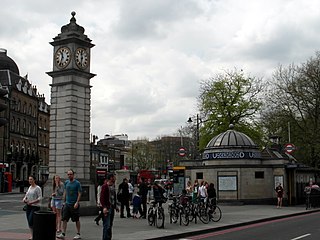
Clapham is a district in south west London, England, lying mostly within the London Borough of Lambeth, but with some areas extending into the neighbouring London Borough of Wandsworth.

Vauxhall is a district in South West London, part of the London Borough of Lambeth, England. Vauxhall was part of Surrey until 1889 when the County of London was created. Named after a medieval manor, "Fox Hall", it became well known for the Vauxhall Pleasure Gardens.

Lambeth is a London borough in South London, England, which forms part of Inner London. Its name was recorded in 1062 as Lambehitha and in 1255 as Lambeth. The geographical centre of London is at Frazier Street near Lambeth North tube station, though nearby Charing Cross on the other side of the Thames in the City of Westminster is traditionally considered the centre of London.

The 1981 Brixton riot, or Brixton uprising, was a series of clashes between mainly black youths and the Metropolitan Police in Brixton, London, between 10 and 12 April 1981. It resulted from racist discrimination against the black community by the mainly white police, especially the police's increased use of stop-and-search in the area, and ongoing tensions resulting from the deaths of 13 black teenagers and young adults in the suspicious New Cross house fire that January. The main riot on 11 April, dubbed "Bloody Saturday" by Time magazine, resulted in 279 injuries to police and 45 injuries to members of the public; over a hundred vehicles were burned, including 56 police vehicles; almost 150 buildings were damaged, thirty of which were burnt out, and many shops were looted. There were 82 arrests. Reports suggested that up to 5,000 people were involved. The Brixton riot was followed by similar riots in July in many other English cities and towns. The Thatcher government commissioned an inquiry, which resulted in the Scarman Report.
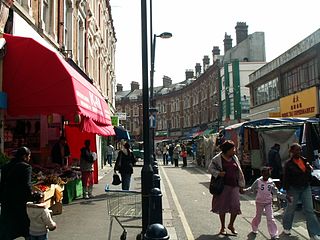
Electric Avenue is a street in Brixton, London. Built in the 1888, it was the first market street to be lit by electric lights, later, an iron and glass canopy was installed. . Today, Electric Avenue contains national retail chains, various local food and housewares retailers, and hosts a part of Brixton Market, which specialises in selling African, Caribbean, South American and South Asian products. It is located just around the corner from Brixton Underground station (1972). The street originally had cast iron Victorian canopies over the pavements which were damaged in WWII, and removed in the 1980s.
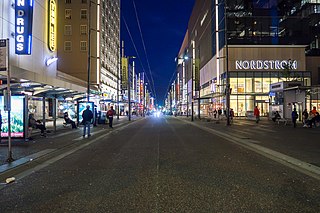
Granville Street is a major street in Vancouver, British Columbia, Canada, and part of Highway 99. Granville Street is most often associated with the Granville Entertainment District and the Granville Mall. This street also cuts through residential neighbourhoods like Shaughnessy and Marpole via the Granville Street Bridge.

David Greig was initially a grocery store that grew to become one of the burgeoning supermarket chains in the United Kingdom. The original business was founded by the Greig family of Hornsey, North London. During the seventies, the business was first purchased by Wrensons, a Midlands-based grocery chain before the combined group took on the David Greig name. The combined company was purchased by British food conglomerate Fitch Lovell and was eventually merged into the group's supermarket chain Key Markets.
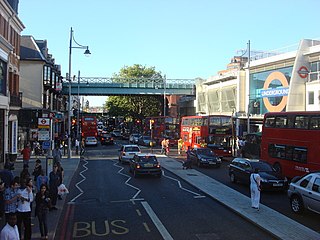
Brixton Road is a road in the London Borough of Lambeth, leading from the Oval at Kennington to Brixton, where it forms the high street and then forks into Effra Road and Brixton Hill at St Matthew's church at the junction with Acre Lane and Coldharbour Lane. Brixton Market is located in Electric Avenue near Brixton Underground station and in a network of covered arcades adjacent to the two railway viaducts. The market arcades were declared listed buildings in 2009 following controversial proposals by Lambeth Council to replace them with a large US-style mall. The former "Brixton Oval" is at the southern end with Lambeth Town Hall, the Ritzy Cinema, the Brixton Tate Library and St Matthew's church. The space was renamed Windrush Square in 2010, in honour of the area's early Caribbean migrants and the HMT Empire Windrush, which in 1948 brought 492 passengers from Jamaica to London.
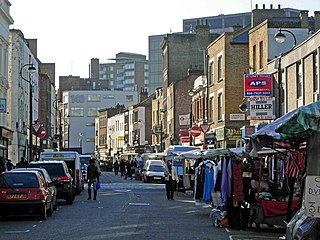
Lower Marsh is a street in the Waterloo neighbourhood of London, England. It is adjacent to Waterloo railway station in the London Borough of Lambeth. It is the location of Lower Marsh Market.
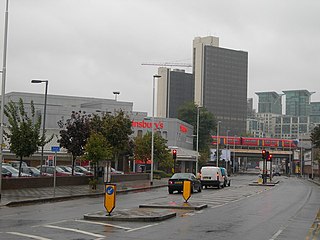
The A3036 is an A road in London, England, running from Waterloo to Wandsworth.

Loughborough Junction is an area of South London, in the London Borough of Lambeth, which is located equidistant between Brixton, Camberwell and Herne Hill.
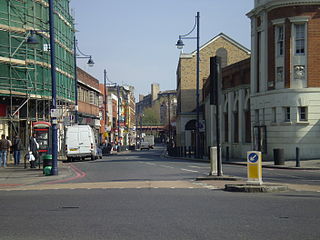
Coldharbour Lane is a road in south London, England, that leads south-westwards from Camberwell to Brixton. The road is over 1 mile (1.6 km) long with a mixture of residential, business and retail buildings – the stretch of Coldharbour Lane near Brixton Market contains shops, bars and restaurants. Between the junctions of Coldharbour Lane and Denmark Hill in Camberwell SE5 and Coldharbour Lane and Denmark Road lies part of the boundary between Lambeth and Southwark boroughs. The other end of Coldharbour Lane meets Acre Lane in central Brixton to form the A2217.

East Brixton railway station was a railway station in Brixton, south London. It was opened as Loughborough Park by the London, Brighton & South Coast Railway in 1866. Regular passenger service was the South London line from London Victoria to London Bridge terminal stations in central London. Initially provided with a steam passenger service, competition from electric trams caused a conversion to overhead line electric operation in 1909. The station became part of the Southern Railway in 1923 and overhead line electrification was swapped for third rail in 1928. The station lost patronage after the opening of Brixton Underground station in 1971. There was a fire at the station in 1975 and it was closed by British Rail in January 1976. The station was located next to the rail bridge over Barrington Road, near Coldharbour Lane. Since 2012 London Overground trains pass through the site of the former station without stopping and there has been some campaigning to reopen it.

The Brixton murals are a series of murals by local artists in the Brixton area, in south London. Most of the murals were funded by Lambeth London Borough Council and the Greater London Council after the Brixton riots in 1981.
Coldharbour ward was an administrative division of the London Borough of Lambeth from 2002 to 2022. It is located in Brixton. The ward was replaced in 2022 by Brixton Acre Lane, Brixton Rush Common, Brixton Windrush, Herne Hill and Loughborough Junction, and Brixton North.

Temperance Billiard Hall Co. Ltd. was a company founded in 1906 in Pendleton, Lancashire, as part of the wider temperance movement, which built billiard halls in the north of England and London.

Loughborough Road is in Brixton, in the south London Borough of Lambeth. Running between Brixton Road and Loughborough Junction, it has always been mainly residential, but in the past two centuries has included many shops and taverns.
The Brixton Immortals Domino Club formed in the 1970s, as a team and wider community social club playing Dominoes in Brixton, London, United Kingdom.


















